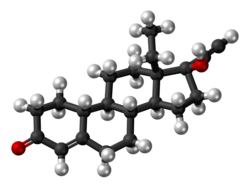 | |
 | |
| Clinical data | |
|---|---|
| Trade names | Plan B, Plan B One-Step, others |
| Other names | LNG; LNG-EC; d-Norgestrel; d(–)-Norgestrel; D-Norgestrel; WY-5104; SH-90999; NSC-744007; 18-Methylnorethisterone; 17α-Ethynyl-18-methyl-19-nortestosterone; 17α-Ethynyl-18-methylestr-4-en-17β-ol-3-one; 13β-Ethyl-17α-hydroxy-18,19-dinorpregn-4-en-20-yn-3-one |
| AHFS/Drugs.com | Monograph |
| MedlinePlus | a610021 |
| Pregnancy category | |
| Routes of administration | By mouth, transdermal patch, intrauterine device, subcutaneous implant |
| Drug class | Progestogen (medication); Progestin |
| ATC code | |
| Legal status | |
| Legal status | |
| Pharmacokinetic data | |
| Bioavailability | 95% (range 85–100%) [8] [9] |
| Protein binding | 98% (50% to albumin, 48% to SHBG ) [8] |
| Metabolism | Liver (reduction, hydroxylation, conjugation) [8] [10] |
| Metabolites | • 5α-Dihydro-LNG [8] |
| Elimination half-life | 24–32 hours [8] |
| Excretion | Urine: 20–67% Feces: 21–34% [10] |
| Identifiers | |
| |
| CAS Number | |
| PubChem CID | |
| IUPHAR/BPS | |
| DrugBank | |
| ChemSpider | |
| UNII | |
| KEGG | |
| ChEBI | |
| ChEMBL | |
| CompTox Dashboard (EPA) | |
| ECHA InfoCard | 100.011.227 |
| Chemical and physical data | |
| Formula | C21H28O2 |
| Molar mass | 312.453 g·mol−1 |
| 3D model (JSmol) | |
| Melting point | 235 to 237 °C (455 to 459 °F) |
| |
| |
| (verify) | |
Levonorgestrel is a hormonal medication used in a number of birth control methods. [7] [11] It is combined with an estrogen to make combination birth control pills. [12] As an emergency birth control, sold under the brand names Plan B One-Step and Julie, among others, it is useful within 72 hours of unprotected sex. [7] [11] [13] The more time that has passed since sex, the less effective the medication becomes. [11] Levonorgestrel works by preventing or delaying ovulation so an egg cannot be released. The dosage used for emergency contraception is ineffective when ovulation has already occurred, and has been found to have no effect on implantation. [14] It decreases the chances of pregnancy by 57–93%. [15] In an intrauterine device (IUD), such as Mirena among others, it is effective for the long-term prevention of pregnancy. [11] A levonorgestrel-releasing implant is also available in some countries. [16]
Contents
- Medical uses
- Birth control
- Emergency birth control
- Hormone therapy
- Available forms
- Contraindications
- Side effects
- Overdose
- Interactions
- Pharmacology
- Pharmacodynamics
- Pharmacokinetics
- Chemistry
- History
- Society and culture
- Generic names
- Brand names
- Availability
- Accessibility
- Research
- References
- External links
Common side effects include nausea, breast tenderness, headaches, and increased, decreased, or irregular menstrual bleeding. [11] When used as an emergency contraceptive, if pregnancy occurs, there is no evidence that its use harms the fetus. [11] It is safe to use during breastfeeding. [11] Birth control that contains levonorgestrel will not change the risk of sexually transmitted infections. [11] It is a progestin and has effects similar to those of the hormone progesterone. [11] It works primarily by preventing ovulation and closing off the cervix to prevent the passage of sperm. [11]
Levonorgestrel was patented in 1960 and introduced for medical use together with ethinylestradiol in 1970. [17] [18] It is on the World Health Organization's List of Essential Medicines. [19] It is available as a generic medication. [20] In the United States, levonorgestrel-containing emergency contraceptives are available over the counter (OTC) for all ages. [21] In 2020, it was the 323rd most commonly prescribed medication in the United States, with more than 800 thousand prescriptions. [22]
